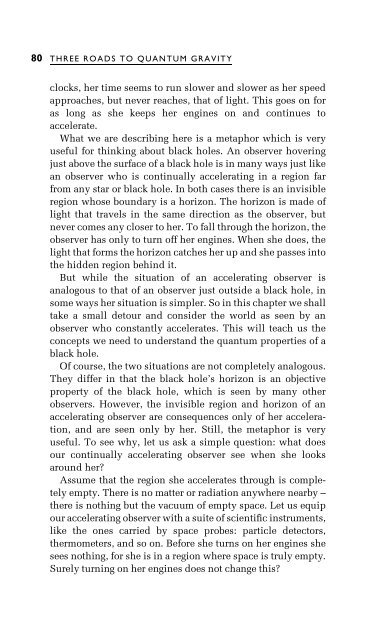Three Roads To Quantum Gravity
Three Roads To Quantum Gravity
Three Roads To Quantum Gravity
Create successful ePaper yourself
Turn your PDF publications into a flip-book with our unique Google optimized e-Paper software.
80 THREE ROADS TO QUANTUM GRAVITY<br />
clocks, her time seems to run slower and slower as her speed<br />
approaches, but never reaches, that of light. This goes on for<br />
as long as she keeps her engines on and continues to<br />
accelerate.<br />
What we are describing here is a metaphor which is very<br />
useful for thinking about black holes. An observer hovering<br />
just above the surface of a black hole is in many ways just like<br />
an observer who is continually accelerating in a region far<br />
from any star or black hole. In both cases there is an invisible<br />
region whose boundary is a horizon. The horizon is made of<br />
light that travels in the same direction as the observer, but<br />
never comes any closer to her. <strong>To</strong> fall through the horizon, the<br />
observer has only to turn off her engines. When she does, the<br />
light that forms the horizon catches her up and she passes into<br />
the hidden region behind it.<br />
But while the situation of an accelerating observer is<br />
analogous to that of an observer just outside a black hole, in<br />
some ways her situation is simpler. So in this chapter we shall<br />
take a small detour and consider the world as seen by an<br />
observer who constantly accelerates. This will teach us the<br />
concepts we need to understand the quantum properties of a<br />
black hole.<br />
Of course, the two situations are not completely analogous.<br />
They differ in that the black hole's horizon is an objective<br />
property of the black hole, which is seen by many other<br />
observers. However, the invisible region and horizon of an<br />
accelerating observer are consequences only of her acceleration,<br />
and are seen only by her. Still, the metaphor is very<br />
useful. <strong>To</strong> see why, let us ask a simple question: what does<br />
our continually accelerating observer see when she looks<br />
around her?<br />
Assume that the region she accelerates through is completely<br />
empty. There is no matter or radiation anywhere nearby ±<br />
there is nothing but the vacuum of empty space. Let us equip<br />
our accelerating observer with a suite of scienti®c instruments,<br />
like the ones carried by space probes: particle detectors,<br />
thermometers, and so on. Before she turns on her engines she<br />
sees nothing, for she is in a region where space is truly empty.<br />
Surely turning on her engines does not change this?



![arXiv:1001.0993v1 [hep-ph] 6 Jan 2010](https://img.yumpu.com/51282177/1/190x245/arxiv10010993v1-hep-ph-6-jan-2010.jpg?quality=85)


![arXiv:1008.3907v2 [astro-ph.CO] 1 Nov 2011](https://img.yumpu.com/48909562/1/190x245/arxiv10083907v2-astro-phco-1-nov-2011.jpg?quality=85)








![arXiv:1002.4928v1 [gr-qc] 26 Feb 2010](https://img.yumpu.com/41209516/1/190x245/arxiv10024928v1-gr-qc-26-feb-2010.jpg?quality=85)
![arXiv:1206.2653v1 [astro-ph.CO] 12 Jun 2012](https://img.yumpu.com/39510078/1/190x245/arxiv12062653v1-astro-phco-12-jun-2012.jpg?quality=85)
